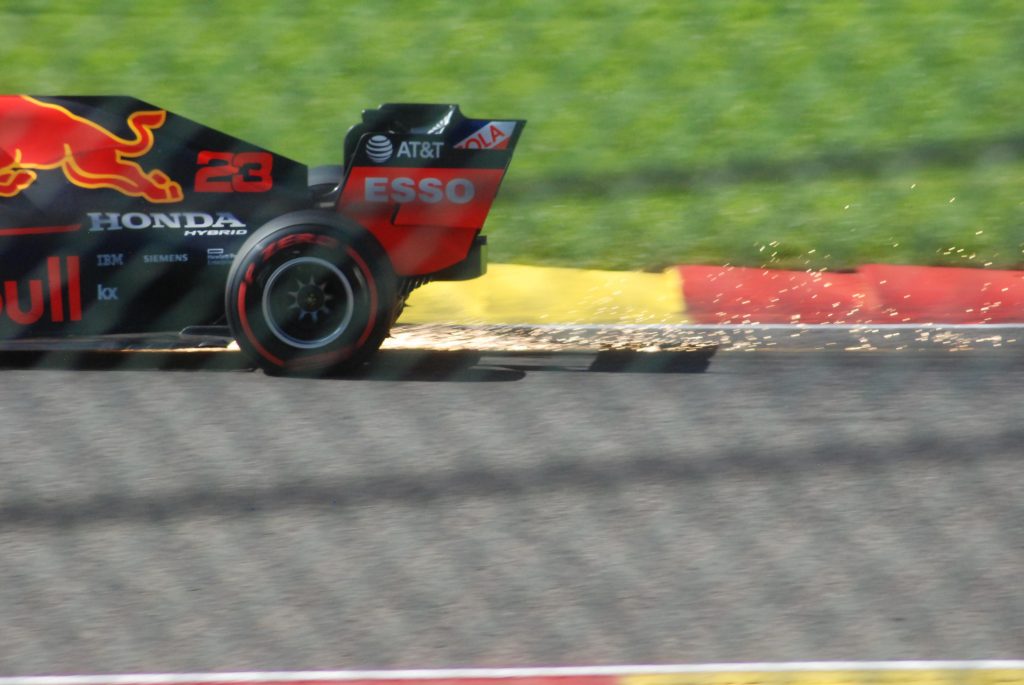
Image by Zack Bhalla. Taken at the F1 2019 Belgian Grand Prix of a Honda-powered Red Bull RB15, driven by Alexander Albon, with the Honda hybrid logo clearly on display.
Widely known amongst car and racing aficionados is Formula One’s unclear future. Combine uncertainty over the outcome of future technical rules with Brexit and the rise of Formula E — an electric car racing series — and one can perhaps be unsurprised the sport has struggled to attract more car manufacturers.
The most recent car manufacturers to affirm their commitment in Formula One were Honda in 2013 (for the 2015 season) and Renault in 2016. Whilst this is arguably encouraging for the pinnacle of motorsport, their newest rival series — Formula E — has attracted more manufacturers in a similar timeframe, despite being a startup series. Such manufacturers include Audi, BMW, Nissan (formerly badged as Renault, as per the Nissan-Renault-Mitsubishi Alliance), Jaguar, Venturi, Mercedes and Porsche, all of whom have committed to the series since the electric series’ inception in 2014. When Porsche’s Formula E entry was announced, Malte Huneke (a project leader for Porsche’s Formula E Team) said the rationale behind entering the electric series was so they could develop electric technologies which will eventually end up in their road cars; a sentiment echoed by Britta Seeger of Daimler, which wants ten electric Mercedes EQ car models available to consumers by 2022.
With such interest and a willingness to invest in a relatively newly-established electric series, one cannot help but wonder what Formula E’s successes mean for Formula One? In many ways, one could argue Formula One has become an old dinosaur, made impracticable by its notoriously large cost barriers. The old philosophy of masses of engineers all crowded around one car and tyres which must be changed in changeable weather conditions may logically affect the costs associated for a manufacturer to compete in Formula One and thus use the sport as a testing ground for new developments. None of these issues exist in Formula E; the technology used does not require lots of engineers and is thus more similar to the circumstances in which battery technology would be used in road cars (according to Huneke). The tyres are also more akin to road tyres. Thus, the smaller cost structure, combined with an ability to more reliably test technology which analysts suggest could be part of the next generation of vehicles, seemingly makes Formula E an attractive prospect for many car manufacturers; arguably improving their return on investment whilst bearing a smaller opportunity cost. If the car industry continues its well-documented shift to electric vehicles, one might wonder how many more car manufacturers may be enticed by the offering of Formula E? Might we, therefore, see the demise of Formula One?
The answer to this question depends on the outcome of new technical regulations for the 2021 Formula One season. If Formula One can achieve its aim of becoming a more cost-effective series with more road car technologies and regulations more akin to Formula E, perhaps the sport can attract a plethora of car manufacturers, in a similar fashion to their electric competitor. One must not forget, car manufacturers do not just enter motorsport series across the world for fun; there is a serious commercial strategy and perceived benefits to the manufacturer, which make their involvement an investment with a tangible return. Such benefits include an ability to improve technologies which are used in electric cars, as well as being to associate the brand with the electric revolution. There is, however, a point which thus far has been neglected which supports Formula One’s position as the future for car manufacturers: hybrid technologies.
For all the issues manufacturers perceive with Formula One which Formula E tries to resolve, regenerative battery and hybrid technologies (from which Formula E has benefitted) first appeared in Formula One in 2009. Regenerative battery technologies have since been fitted to road cars built by manufacturers in Formula One, such as: Renault’s Zoe; Honda’s Clarity PHEV; the entire Mercedes EQ range; McLaren’s P1; and Ferrari’s LaFerrari. These manufacturers have seemingly been able to extract technologies used in Formula One for commercial benefit in current and future road cars. This was then enhanced in 2014, with the introduction of the current turbo hybrid era of engine regulations. Arguably, therefore, this begs the question: ‘is Formula One the future for car manufacturers, after all?’
Figures show hybrid vehicle sales in the UK (which use regenerative braking technologies and other engine technologies used in Formula One) have reached the 16,000 units per month post twice between January 2016 and May 2019. These sales appear to have an upward trajectory. Similar figures for pure electric cars between January 2016 and January 2019 saw the 3,000 unit sales barrier only broken once, although still on an upwards trajectory from arguably a lower starting point.
Therefore, one might argue Formula One does have a future for car manufacturers, given the recent popularity and commercial successes of hybrid cars which use the technology seen in Formula One. In spite of this, the longevity of Formula One’s usefulness to car manufacturers may depend on the success of the 2021 rule changes. Formula E, by focusing solely on battery technologies, may have a more certain future which car manufacturers perceive as a less risky investment at a time of political and economic uncertainty (such as Brexit). Perhaps this explains why Mercedes has committed to both Formula One and Formula E: so as to develop technologies for the majority of current road car demands (in the form of hybrid cars) and for those early adopters wanting electric cars; which common belief suggests is likely to become the standard fuel type in the future.
